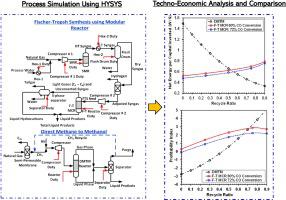Catalysis Today ( IF 5.2 ) Pub Date : 2020-07-29 , DOI: 10.1016/j.cattod.2020.07.012 Gustavo Rocha Silva Santos , Omar M. Basha , Rui Wang , Husain Ashkanani , Badie Morsi

|
The aim of this study is to perform a techno-economic assessment of the Fischer-Tropsch synthesis (FTS) process in a microchannel reactor (MCR) to produce clean syncrude, and the Direct Methane to Methanol (DMTM) process in a compact plant footprint. The operational and economic performances of the two processes were modeled using the Aspen HYSYS v7.2. The operational performance parameters include products yield and the economic performance parameters include net present value (NPV), payback period (PBP) and internal rate of return (IRR). In addition, the effects of tailgas recycle ratios and water integration on the performances of the FTS process and the effect of methane recycle ratios on the performances of the DMTM were investigated. The simulation results showed that the unit cost of the DMTM process was sensitive to the methane recycle ratio, however, that of the FTS in MCR was less sensitive to the tailgas recycle ratios. In order to maintain an IRR > 10 %, the tail gas recycle ratio of the FTS in MCR had to be greater than 8 % and 30 %, at CO conversions of 80 % and 72 %, respectively, whereas in the DMTM process, a minimum methane recycle ratio of 60 % was required to achieve any profitability. In addition, the DMTM process appeared to have significantly higher net energy requirements per product yield when compared with those of the FTS in MCR process; however, both processes had higher energy requirements than those of conventional GTL technologies.
中文翻译:

模块化GTL反应器中费-托合成和直接甲烷制甲醇工艺的技术经济评估
这项研究的目的是对微通道反应器(MCR)中的费-托合成(FTS)工艺进行生产,以生产干净的混合物,并在紧凑的工厂占地面积内进行直接甲烷转化为甲醇(DMTM)工艺的技术经济评估。 。使用Aspen HYSYS v7.2对这两个过程的运营和经济绩效进行了建模。运营绩效参数包括产品产量,经济绩效参数包括净现值(NPV),投资回收期(PBP)和内部收益率(IRR)。此外,还研究了尾气再循环率和水整合度对FTS工艺性能的影响以及甲烷再循环率对DMTM性能的影响。模拟结果表明,DMTM工艺的单位成本对甲烷再循环率敏感,而MCR中FTS的单位成本对尾气再循环率较不敏感。为了保持IRR> 10%,在MCR中,FTS的尾气再循环率必须分别大于8%和30%,CO转化率分别为80%和72%,而在DMTM工艺中,要获得任何利润,最低的甲烷再循环率必须达到60%。另外,与MCR过程中的FTS相比,DMTM过程似乎对每产品产量的净能量需求要高得多。但是,这两个过程都比常规GTL技术具有更高的能源需求。10%时,MCR中FTS的尾气再循环率必须大于8%和30%,CO转化率分别为80%和72%,而在DMTM工艺中,最小甲烷再循环率为60%需要实现任何盈利能力。另外,与MCR过程中的FTS相比,DMTM过程似乎对每产品产量的净能量需求要高得多。但是,这两个过程都比常规GTL技术具有更高的能源需求。10%时,MCR中FTS的尾气再循环率必须大于8%和30%,CO转化率分别为80%和72%,而在DMTM工艺中,最小甲烷再循环率为60%需要实现任何盈利能力。另外,与MCR过程中的FTS相比,DMTM过程似乎对每产品产量的净能量需求要高得多。但是,这两个过程都比常规GTL技术具有更高的能源需求。与MCR工艺中的FTS相比,DMTM工艺中每产品产量的净能量需求似乎要高得多;但是,这两个过程都比常规GTL技术具有更高的能源需求。与MCR工艺中的FTS相比,DMTM工艺中每产品产量的净能量需求似乎要高得多;但是,这两个过程都比常规GTL技术具有更高的能源需求。











































 京公网安备 11010802027423号
京公网安备 11010802027423号